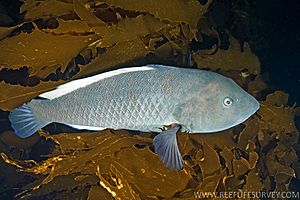Inscribed wrasse facts for kids
Quick facts for kids Inscribed wrasse |
|
|---|---|
 |
|
| male | |
| Conservation status | |
| Scientific classification | |
| Synonyms | |
|
The inscribed wrasse (Notolabrus inscriptus) is a type of wrasse. This is a ray-finned fish that belongs to the family called Labridae. You can find this fish in the southwestern Pacific Ocean.
Contents
What Does It Look Like?
The inscribed wrasse is a large fish for its group. The biggest males can grow up to about 32.5 centimeters (12.8 inches) long. Some say they can even reach 50 centimeters (20 inches)!
Young Fish and Females
When they are young, these fish are greenish. They have white marks and a special "eyespot" on their back fin. Another eyespot is on their bottom fin.
Female inscribed wrasses are brown. They have white marks on their scales. These marks look like thin stripes running along their body.
Male Fish
Male inscribed wrasses are bluish-grey. Their bodies have an uneven pattern that looks like scribbles. This scribbled pattern is why they are called "inscribed" wrasses. The males also have white fins on their back and bottom.
Where Does It Live?
The inscribed wrasse lives in the eastern part of Australia. This includes places like Lord Howe Island and Norfolk Island. You can also find them near the Kermadec Islands. In New Zealand, they live along the northeast coast of the North Island. Their range goes from Cape Reinga down to East Cape.
This fish is not very common near the main Australian coasts. However, it is found in large numbers around Lord Howe Island, Norfolk Island, and the Kermadec Islands.
Habitat and Life
Inscribed wrasses like to live around kelp beds. They are often found on rocky reefs. They usually swim at depths of about 17 meters (56 feet).
What Do They Eat?
These wrasses are carnivores. This means they eat other animals. They mostly feed on small creatures that live on the seafloor. These creatures are called benthic invertebrates. Their favorite foods include molluscs (like snails or clams) and crustaceans (like crabs or shrimp).
Social Life
Like other fish in their genus Notolabrus, the male inscribed wrasses form harems. A harem is a group of females and young fish that live in a male's territory. The male fish defends this area. In this species, a male's harem usually has about six females or young fish.
About Its Name
The inscribed wrasse was first officially described in 1848. A Scottish naturalist named John Richardson gave it the scientific name Labrus inscriptus. He found the first example of this fish near Norfolk Island.
See also
 In Spanish: Notolabrus inscriptus para niños
In Spanish: Notolabrus inscriptus para niños


